The AMD Zen and Ryzen 7 Review: A Deep Dive on 1800X, 1700X and 1700
by Ian Cutress on March 2, 2017 9:00 AM ESTConclusion
The march towards Ryzen has been a long road for AMD. Anyone creating a new CPU microarchitecture deserves credit as designing such a complex thing requires millions of hours of hard graft. Nonetheless, hard graft doesn’t always guarantee success, and AMD’s targets of low power, small area, and high-performance while using x86 instructions was a spectacularly high bar, especially with a large blue incumbent that regularly outspends them in R&D many times over.
Through the initial disclosures on the Zen microarchitecture, one thing was clear when speaking to the senior staff, such as Dr. Lisa Su, Mark Papermaster, Jim Anderson, Mike Clark, Sam Naffziger and others: that quiet confidence an engineer gets when they know their product is not only good but competitive. The PR campaign up until this point of launch has been managed (we assume) such that the trickle of information comes down the pipe and keeps people on the edge of their seat. Given the interest in Ryzen, it has worked.
Ryzen is AMD’s first foray into CPUs on 14nm, and using FinFETs, as well as a new microarchitecture and pulling in optimization methods from previous products such as Excavator/Carrizo and the GPU line. If we were talking tick-tock strategy, such as Intel’s process over the last decade, this is both a tick and a tock in one. Ryzen is the first part of that strategy, on the desktop processors first, with server parts coming out in Q2 and Notebook APUs in 2H17. One of the main concerns with AMD is typically the ability to execute – get enough good parts out on time and with sufficient performance to merit their launch. As Dr. Su said in our interview, it’s one big hurdle but there are many to come.
| AMD Ryzen 7 SKUs | ||||||
| Cores/ Threads |
Base/ Turbo |
L3 | TDP | Cost | Launch Date | |
| Ryzen 7 1800X | 8/16 | 3.6/4.0 | 16 MB | 95 W | $499 | 3/2/2017 |
| Ryzen 7 1700X | 8/16 | 3.4/3.8 | 16 MB | 95 W | $399 | 3/2/2017 |
| Ryzen 7 1700 | 8/16 | 3.0/3.7 | 16 MB | 65 W | $329 | 3/2/2017 |
Today’s launch of three CPUs, part of the Ryzen 7 family, will be followed by Ryzen 5 in Q2 and Ryzen 3 later in the year. Ryzen 7 uses a single eight-core die, and uses simultaneous multi-threading (SMT) to provide sixteen threads altogether, up to 4.0 GHz on the top Ryzen 7 1800X chip for $499. Officially AMD is positioning the 1800X as a direct competitor to Intel’s i7-6900K, an 8-core processor with hyperthreading that costs over $1000. In our benchmarks, it’s been clear that this battle goes toe-to-toe.
Analyzing the Results
In the brief time we had before getting a sample and this review, we were able to run our new benchmark suite on twelve different Intel CPUs, as well as AMD’s former APU crown holder, the A10-7890K. Throughout the discussion about Ryzen, AMD was advertising a 40%+ gain in raw performance per clock over their previous generations, which was then upped to 52% when the CPUs were actually announced. Back of the envelope calculations put Ryzen at the level of the high-end desktop Broadwell CPUs or just about, which means it would be a case of pure frequency. That being said, Intel is already running CPUs two generations ahead on its mainstream platform, such as the Kaby-Lake based i7-7700K, so it’s going to be an interesting analysis.
Multi-Threaded Tests
First up, AMD’s strength in our testing was clearly in the multithreaded benchmarks. Given the microarchitectures of AMD’s and Intel’s high-performance x86 cores are somewhat similar, for the most part there’s a similar performance window. Intel’s design is slightly wider and has a more integrated cache hierarchy, meaning it manages to win out on ‘edge cases’ that might be a result of bad code. As one might expect, it takes a lot of R&D to cater for particular edge cases.
But as a workstation-based core design, the Zen microarchitecture pulls no punches. As long as the software doesn’t need strenuous AVX code, and manages its memory carefully (such as false sharing), the performance of Ryzen in conventional multi-threaded CPU environments means AMD is back in the game. This is going to be beneficial for the Zen microarchitecture when we see it applied into server environments, especially those that require virtualization.
Single Threaded Tests
Since the launch of Bulldozer, AMD has always been a step behind on single-threaded performance. ST performance is a holy-grail of x86 core design, but often requires significantly advanced features that can potentially burn extra power to get there. AMD’s message on this, even in our interview with Dr. Su, is that AMD has the ability to innovate. This is why AMD promotes features such as SenseMI for their new advanced pre-fetch algorithms, why implementing a micro-op cache into the core was a big thing, and how having double the L2 cache over Intel’s comparable parts were important to the story. Nonetheless, AMD hammered down that a 40%+ IPC gain into its narrative, which then folded into a 52% gain at launch. We’ll take a deeper look into this in a separate review, but our single threaded results show that AMD is back in the fight.
Most of the data points in this graph come from Intel Kaby Lake processors at various frequencies, but the important thing here is that the Ryzen parts are at least in the mix, sitting above the other eight core parts on the far right of the graph. Also, the jump from the A10 up to the 1700 is a big generational jump, let alone considering the 1800X.
Overall Performance
Putting these two elements into the same graph gives the following:
By this measure, for overall performance, it’s clear the Core i7-7700K is still better in price/performance. However, AMD would argue that the competition for the Ryzen 7 parts is on the right, with the i7-6900K and i7-5960X. In our CPU-based results, AMD wins this performance per dollar hands down.
Some Caveats
Since testing this review, and waiting a few days to even write the conclusion, there has been much going on about ways in which AMD’s performance is perhaps being neutered. This list includes discussions around:
- Windows 10 RTC disliking 0.25x multipliers, causing timing issues,
- Software not reading L3 properly (thinking each core has 8MB of L3, rather than 2MB/core),
- Latency within a CCX being regular, but across CCX boundaries having limited bandwidth,
- Static partitioning methods being used shows performance gains when SMT is disabled,
- Ryzen showing performance gains with faster memory, more so than expected,
- Gaming Performance, particularly towards 240 Hz gaming, is being questioned,
- Microsoft’s scheduler not understanding the different CCX core-to-core latencies,
- Windows not scheduling threads within a CCX before moving onto the next CCX,
- Some motherboards having difficulty with DRAM compatibility,
- Performance related EFIs being highly regularly near weekly since two weeks before launch.
A number of these we are already taking steps to measure. Some of the fixes to these issues come from Microsoft’s corner, and we are already told that both AMD and Microsoft are underway to implement scheduling routines to fix these. Other elements will be AMD focused: working with software companies to ensure that after a decade of programming for the other main x86 microarchitecture, it’s a small step to also consider the Zen platform.
At this point, we’re unsure at what level some of these might be default design issues with Zen. The issue of single-thread performance increasing when SMT is disabled (we’ve done some pre-testing, up to 6% in ST) is clearly related to the design of the core, with static partitioning vs competitive partitioning of certain parts of the design. The CCX latency and detection is one that certainly needs further investigation.
The future according to Senior Fellow Mike Clark, one of the principle engineers on the Zen microarchitecture, is that AMD knows where the easy gains are for their next generation product (codenamed Zen 2), and they're already working through the list. A question is then if Intel continues at 5% performance gains clock for clock each year, can AMD make 5-15% and close the gap?
The Silver Lining
It is relevant to point out that Intel is on its 7th Generation of Core microarchitecture. Sure, it looks significantly different when it was designed, but software vendors have had seven generations to optimize for it. Coming in and breaking the incumbent’s stranglehold is difficult, when every software vendor knows that design in and out. While AMD’s design looks similar to Intel, there are nuances which programmers might not have expected, and so it might be a good couple of years before the programming guides have made their way through into production software.
But,
When we look at the CPU benchmarks as part of this review, which have a strong range in algorithm difficulty and dependency, AMD still does well. There’s no getting around that AMD has a strong workstation core design on their hands. This bodes well for users who need compute at a lower cost, especially when you can pick up an eight-core Ryzen 7 at half the cost of the competition.
This makes the server story for AMD, under Naples, much more interesting.
AnandTech Recommended Award
For Performance/Price on a Workstation CPU


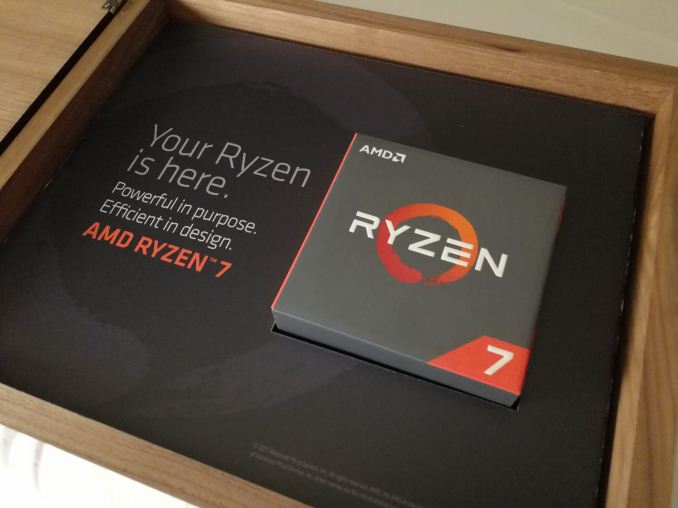
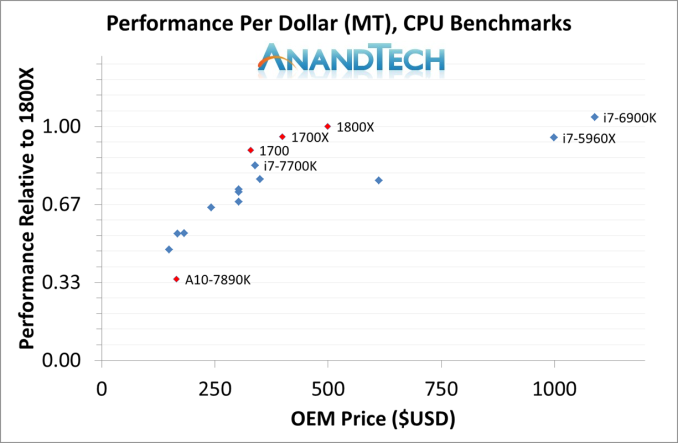
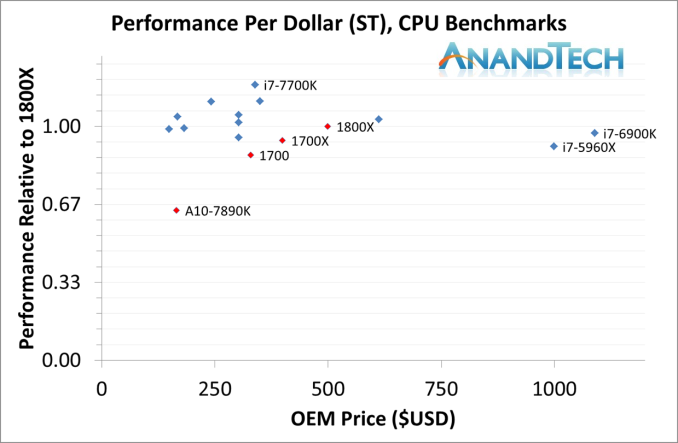
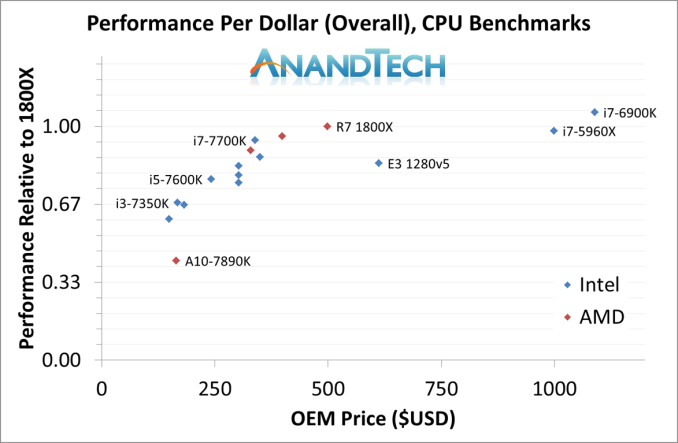
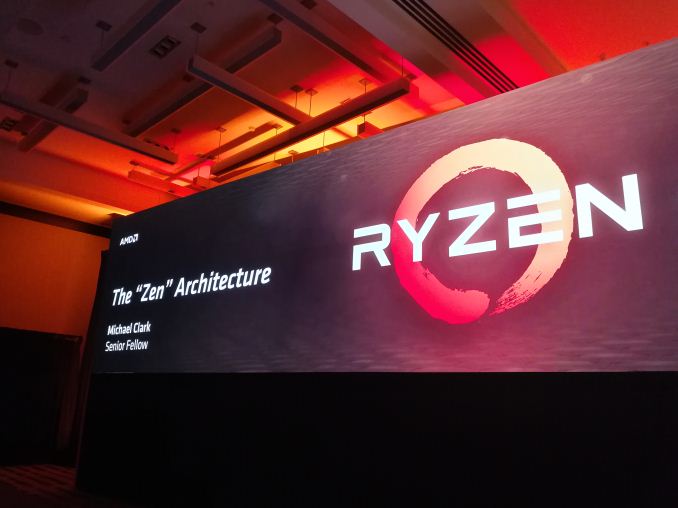










574 Comments
View All Comments
mapesdhs - Thursday, March 2, 2017 - link
It would be bizarre if they weren't clocked a lot higher, since there'll be a greater thermal limit per core, which is why the 4820K is such a fun CPU (high-TDP socket, 40 PCIe lanes, but only 4 cores so oc'ing isn't really limited by thermals compared to 6-core SB-E/IB-E) that can beat the 5820K in some cases (multi-GPU/compute).Meteor2 - Friday, March 3, 2017 - link
...Silverblue, look at the PDF opening test. What comes top? It's not an AMD chip.Cooe - Sunday, February 28, 2021 - link
Lol, because opening PDF's is where people need/will notice more performance? -_-CPU's have been able to open up PDF's fast enough to be irrelevant since around the turn of the century...
rarson - Thursday, March 2, 2017 - link
"AMD really isn't offering anything much for the mid range or regular desktop user either."So I'd HIGHLY recommend you wait 3 months, or overpay for Intel stuff. Because the lower-core Zen chips will no doubt provide the same performance-per-dollar that the high-end Ryzen chips are offering right now.
rarson - Thursday, March 2, 2017 - link
"their $499 CPU is often beaten by an i3."It's clear that you're looking at raw benchmark numbers and not real-world performance for what the chip is designed. If all you need is i3 performance, then why the hell are you looking at an 8-core processor that runs $329 or more?
Ratman6161 - Friday, March 3, 2017 - link
Its all academic to me. As I posted elsewhere, my i7-2600K is still offering me all the performance I need. So I'm just reading this out of curiosity. I also really, really want to like AMD CPU's because I still have a lot of nostalgia for the good old days of the Athlon 64 - when AMD was actually beating Intel in both performance and price. And sometimes I like to tinker around with the latest toys even if I don't particularly need it. I have a home lab with two VMWare ESXi systems built on FX-8320's because at the time they were the cheapest way to get to 8 threads - running a lot of VM's but with each VM doing light work.I also run an IT department so I'm always keeping tabs on what might be coming down the pike when I get ready to update desktops. But there is a sharp divide between what I buy for myself at home and what I buy for users at work. At work, most of our users actually would do fine with an i3. But I'm also keeping an eye out for what AMD has on offer in this range.
Notmyusualid - Tuesday, March 7, 2017 - link
@ Jimster480Sorry pal, but that is false, or inaccurate information.
ALL BUT the lowest model of CPUs in the 2011v3 platform are 40 PCIE lanes. Again, only the entry-level chip (6800K),has 28 lanes:
http://www.anandtech.com/show/10337/the-intel-broa...
But I do agree with you, that this is competing against the HEDT line.
Peace.
slickr - Thursday, March 2, 2017 - link
I'm sorry, but that sound just like Intel PR. I don't usually call people shills, but your reply seems to be straight out of Intel's PR book! First of all more and more games are taking advantage of more cores, you can easily see this especially with DX12 titles where if you have even 16 cores it will take advantage of.So having 8 cores for $330 to $500 is incredible value! We also see that the Ryzen chips are all competitive compared to the $1100 6900k which is where the comparison should be. Performance on 8 cores.
And as I've found out real world performance on 8 cores compared to 4 cores is like night and day. Have you tried running a demanding game, streaming in through OBS to Twitch, with the browser open to read Twitch chat and check other stuff in the process, while also having musicbee open and playing your songs and a separate program to read Twitch donations and text, etc...
This is where 4 core struggles a lot, while 8 core responsiveness is perfect. I can't use my PC if I decide to reduce a video size to a smaller one with a 4 core. Even 8 cores are fully taken advantage off, but through one core you can always do other stuff like watch movie or surf the internet without it struggling to process.
But even if games are your holy grail and what you base your opinion on, then Ryzen does really well. Its equal or slightly slower than the much much more optimized Intel processors. But you have to keep in mind a lot of the game code is optimized solely for Intel. That is what most gamers use, in fact over 80% is Intel based gamers, but developers will optimize for AMD now that they have a competitor on their hands.
We see this all the time, with game developers optimizing for RX 400 series a lot, even though Nvidia has the large majority of share in the market. So I expect to see anywhere from 10% to 25% more performance in games and programs that are also optimized for AMD hardware.
lmcd - Thursday, March 2, 2017 - link
How can you call someone a shill and post this without any self-awareness? Your real-world task is GPU-constrained anyway, since you should be using a GPU capable of both video encode and rendering simultaneously. If not, you can consider excellent features like Intel's Quick Sync, which works even with a primary GPU in use these days.Meteor2 - Friday, March 3, 2017 - link
Game code is optimised for x86.